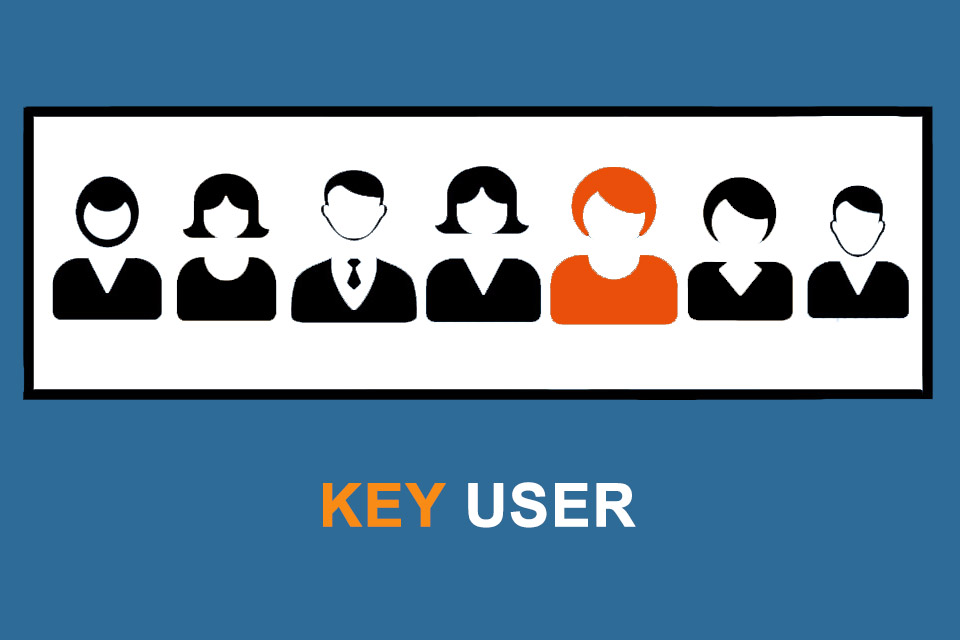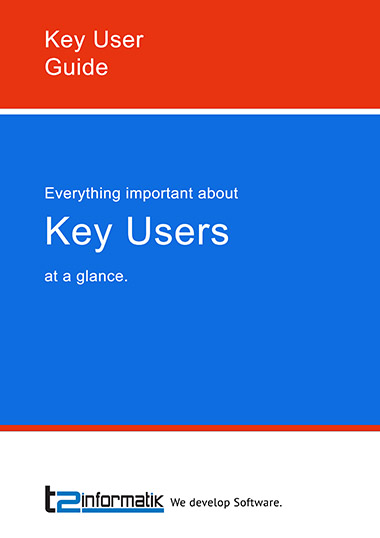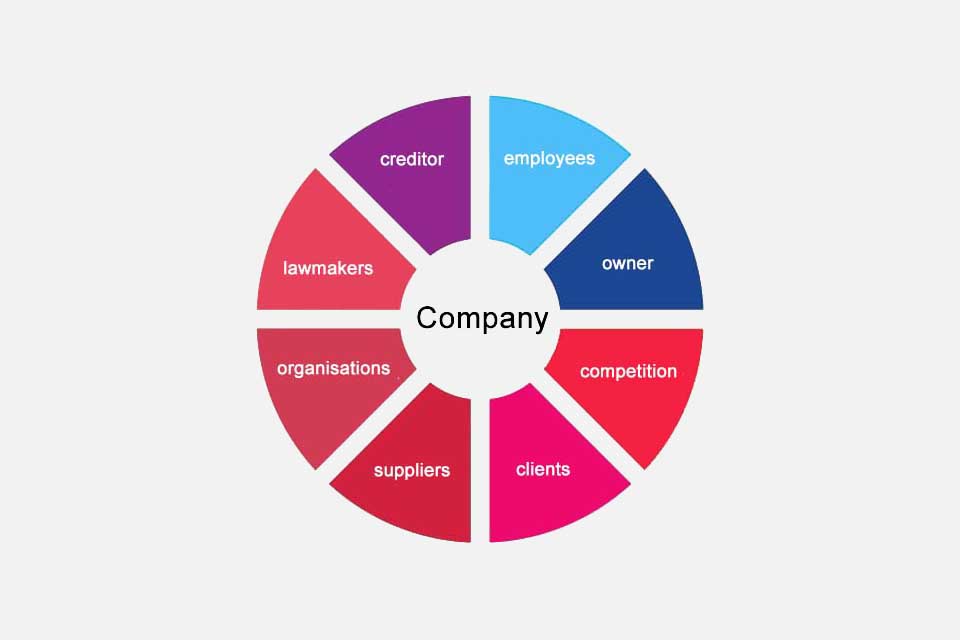What is a Key User?
Table of Contents: Definition – Key user concept – Tasks and functions – Advantages and disadvantages – Questions from the field – Download – Notes
Smartpedia: A key user is a person in an organisation who specialises in the use of a product and serves as the primary contact for questions about the product.
Key user definition
A key user is a person in an organisation who specialises in a product or software and is considered the primary contact person for the product or software. The work of the key user is a key to the successful use of a solution. To drive usage, this person acts as a trainer, coach, multiplier and ambassador, among other things.
Companies interpret the role of the key user differently:
- in larger organisations it is often explicitly defined and assigned,
- whereas in smaller ones it is implicitly taken on by the person with the most knowledge and/or experience.
Either way, it helps with questions and problems, increases acceptance for a product in the organisation, increases the use or depth of use of a software and actively contributes to its amortisation.
The key user concept in companies
A key user is primarily a company-internal contact person for questions about the operation of a product, the use of software or the adaptation of a solution. If this person acts as so-called first level support, he or she is usually located in a support department, otherwise either as a member of staff in the training area or directly in the specialist department.
The number of key users often increases with the size of a company and the number of products its employees handle: Sometimes it happens that there is exactly one key user for a product in a company. It is also conceivable that there is one key user for a product in department A and another key user for the same product in department B. And it is also possible that there are several key users in a department or division who can be consulted across departments or divisions.
How companies use the key user concept for themselves, and whether they do it consciously and actively at all, is therefore very individual. There is no universal right or wrong.
In practice, it can be observed with increasing company size that the work of and with key users is explicitly promoted. Training courses are held that are aimed at potential key users. And qualification profiles are defined to determine the qualifications, skills, competencies and potential that a person must bring to fill this role.
Speaking of roles: Key user is a role that can be on a business card, but does not have to be. If it is on a business card, it could alternatively say “Application Owner”. In such a case, the primary task of the person with the role is to carry out the correspondingly defined activities. If it is not on the business card – and this is the case with many smaller companies or with products that are only used by a few employees of an organisation – it is often a secondary job. For example, the graphic designer from the marketing department may be approached with questions about software X or software Y, as she is usually most familiar with graphics programmes.
What tasks and functions does a key user perform?
A key user can take on many tasks and functions in a company. Most of the time, he or she works internally. Here are some examples:
- As a supporter, he/she can explain questions about the operation and use of a product.
- As an ambassador, he/she can communicate the underlying idea of a product as well as the motives and goals of the department management or executive board in regard to the use of the software. At the same time, he/she is an ambassador for the department and the users towards the management, as he/she recognises the problems and possible conflicts.
- As a translator, he/she is able to translate terminology within an application into the language of colleagues in order to reduce inhibitions and fear of contact.
- As an administrator, he/she is able to adapt the product or the software in such a way that the work of colleagues is supported in the best possible way.
- As a coach, he/she can explain the functionality and operation of products in a situational way. Furthermore, this person can also mediate in conflicts between participants that arise from the use or non-use of a product.
- As a multiplier, he/she increases knowledge about a product or software and thus contributes to greater use and corresponding amortisation.
- As a motivator, he/she helps with the use of a product, ensures – if possible – individual advantages for the user, has an open ear for further questions and – if meaningful – offers words of praise.
- As a change agent, he/she can explain product innovations to employees as well as collect ideas and requests for improvements and pass them on to product management.
- As a requirements engineer or business analyst, he/she can prioritise the employees’ wishes and initiate the subsequent implementation with the management.
- As a tester, he/she can test both beta versions and actually released versions before they are rolled out in the organisation.
- As a trainer, he/she can communicate the structure and functionality of the product or a new product version. Practical, realistic exercises deepen understanding.
Given the length of the list, it is not surprising that the term power user is often used. Interestingly, the power user can also have an external effect. Here are some examples:
- He/she can communicate as an “expert” with the manufacturer’s support, clearly formulate problems and requirements and demand solutions.
- He/she can support the purchasing department in contract negotiations with the manufacturer, as this person can judge what a product can really do and what it should be able to do.
- He/she can communicate directly with the manufacturer’s sales department and demand new or revised functions
- As a tester, he/she can give the manufacturer well-founded feedback on new functions at an early stage.
With the numerous tasks and functions that a key user can take on, it is hardly surprising that this person comes into contact with many corporate disciplines.
Advantages and disadvantages of the key user concept
The key-user concept offers numerous advantages, but also some disadvantages. Here are some advantages:
- In many organisations the concept exists without anyone actively caring about it or even perceiving it as a concept. This can easily be observed with the example of MS Excel. In most areas, there is one employee who is primarily approached with questions about the software. “Can you please help me with the pivot table?” or: “Where can I find the function with which I can …?” are typical questions in such a situation. No one has singled out the key user as such. It is simply the person with the most available knowledge about a product.
- It reduces the training effort. Not all employees have to know and understand every function of a software down to the last detail. In most cases, it is sufficient to have a good command of a few functions that are used regularly. In such a setting, the key users receive comprehensive training, while the employees receive a more detailed, targeted training.
- It increases the speed of response. Many questions can be answered directly by the main user, so that the path via the manufacturer’s support is only necessary in rare cases – and then gladly by the main user.
- It relieves the workload of other colleagues who may first have to familiarise themselves with a topic in a time-consuming manner in order to be able to answer an important question.
- It increases confidence in the competence of colleagues if they can answer questions easily or adapt software with just a few clicks.
- It also facilitates communication between departments when the needs and challenges are communicated in one voice – that of the key user.
- Skillfully communicated, it can also be perceived in a company as an appreciation of the expertise of individual employees.
Of course, there are disadvantages. Here are some examples:
- In organisations where key users are fully involved in “normal” day-to-day business, there is a risk of overload, especially if many employees have questions or need support.
- If different roles are performed by the same person – e.g. project manager or requirements engineer and key user – conflicts quickly arise. It is particularly bad if these conflicts remain undetected at first glance, but later have serious consequences. For example, the project manager could do without staff training because he, as the main user, knows how a new product works. In such cases, however, software acceptance is almost always unfortunate.
- Key users are rarely neutral. If they are consulted, for example, in the selection of new software, it can happen that they reject new products in order not to jeopardise their own positions as primary contact persons for an already existing software.
It is good that there are some tips to compensate for these disadvantages.
Questions from the field
Here you will find some questions and answers from practice:
In which fields of application and disciplines can a key user act?
The areas of application of a key user can be very diverse, since his or her expertise can provide valuable input for numerous disciplines, e.g.
- in requirements engineering in the definition or evaluation of requirements,
- in process management in the optimisation of processes, the execution of business processes or the implementation of workflows,
- in project management in the project definition or the setting of project goals,
- in product management in formulating product goals or improving the user experience,
- in development with explorative, evolutionary or experimental prototyping,
- in procurement management or purchasing, e.g. in software selection,
- in test management when testing new features or versions,
- in the area of training, e.g. in the creation of training concepts for users, train-the-trainer concepts or the implementation of training courses.
- …
In many areas and disciplines, a key user can contribute or give well-founded feedback based on his or her knowledge. He/she can communicate with the product manager or the product owner, he/she can act as a proxy user, as a stakeholder, as a mentor or as a designated navigator in mob programming. In order to do this, however, he/she must fulfil some requirements and possess some skills.
What are the requirements and prerequisites for a key user?
To be recognised as a key user, two categories of requirements must be met:
- professional and
- personal requirements.
Professional requirements refer to knowledge and experience in relation to the business purpose, corporate objectives and corporate alignment. They include methodological knowledge – e.g. on procedures, principles or good practices – as well as concrete skills in handling the product or software for which the key user is to function as a core user. Personal requirements refer to didactic knowledge, empathy, conflict skills and the interest in cooperation and support with others.
To be able to function as a key user, it is important to fulfil some prerequisites. The person who is to be established as the primary contact person for a product or software must be
- be accepted by the employees,
- undergo regular training in order to be able to answer as many questions as possible competently,
- understand the users’ perspective, goals and challenges; and
- be able to mediate between management and staff when necessary.
If these requirements are met, the key user concept offers many advantages.
What tips are useful for working with a key user?
Here are some tips for working with a key user:
- The tasks can be manifold. If he or she has to carry out these tasks regularly and in addition to full-time work, this will lead to an overload. It is up to the employer to find a structural remedy, e.g. through a different distribution of tasks.
- Depending on the size of an organisation and the number of users of a product, there may be many questions, hints, requests or ideas. Therefore, it can make sense to distribute the role of the key user on several shoulders.
- Theoretically, a key user could also be a supervisor. If it is a smaller organisation or if such a situation has arisen “naturally”, there is probably little that can be done about it. However, if one is selected, it would make sense to ensure that he or she is not a superior. If in doubt, this could lead to employees avoiding questions because they do not want to appear in a bad, ignorant light.
- It is possible that a key user does not know everything about a product despite his or her specialisation. Since competence building is an important factor in the key user’s success, he or she should have the right and the financial support to undergo appropriate training if needed.
- If employees are explicitly appointed as key users by the company, this can lead to disgruntlement among other employees. In this case, the criteria and reasons for selection must be communicated clearly and openly.
- The acceptance of a product rises and falls with the acceptance of its key user. If he or she is seen as an expert, this has a positive effect on the use of a product. If he or she is held in rather low esteem by colleagues internally, this quickly has a negative effect. Again, caution is needed when appointing a person to that role.
- Not every key user is a born trainer, coach or motivator. If necessary, the company can and must explicitly promote such potential.
- Although a key user ideally has a lot of knowledge, experience and skills, he or she should only have one vote in discussions – e.g. on the evaluation of needed functions or even the replacement of the product – like all other participants. The HIPPO effect must be avoided.
And one last tip:
When appointing someone, pay attention not only to professional, but above all to personal characteristics. Only someone who is willing to answer the same questions over and over again to employees, who is willing to look at things from a different perspective and who is willing to meet concerns with empathy is really suited for the role. Without these personal characteristics, a key user is merely a person who can operate a product or software well.
What criteria would you use to determine whether it is worth rolling out an explicit key user concept in a company?
Notes:
In the context of ERP implementations, the role of the key user is often interpreted somewhat differently or more broadly. There, the person with the role acts as a user representative and is a driving force in the analysis, development, deployment and operation phases of a new product. An activity that in many companies is usually taken over by a requirements engineer, a project manager or a business analyst.
If you like the article or would like to discuss it, please feel free to share it in your network. And if you have any comments, please do not hesitate to send us a message.
Here you will find additional information from our Smartpedia section:




